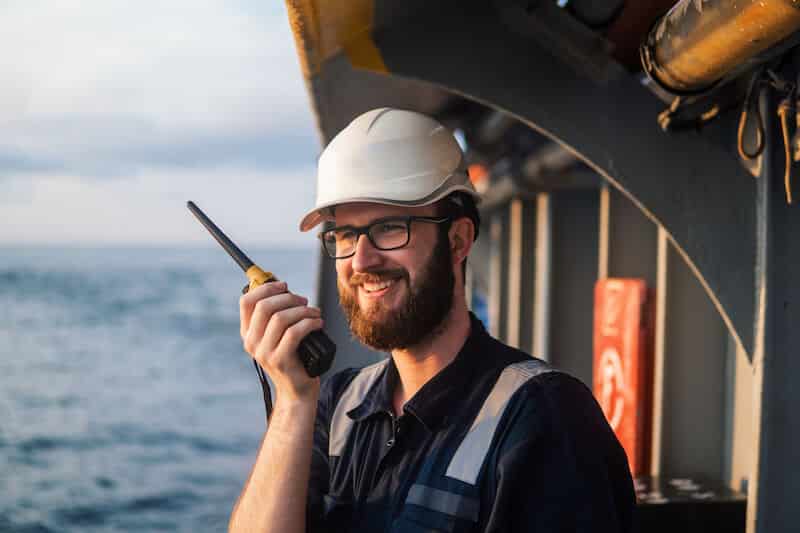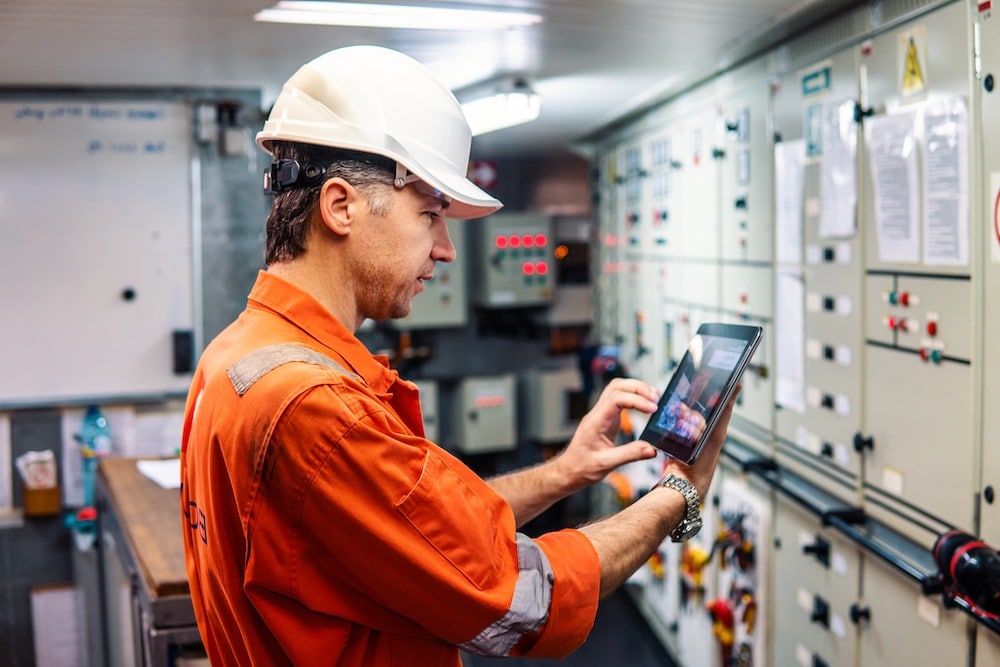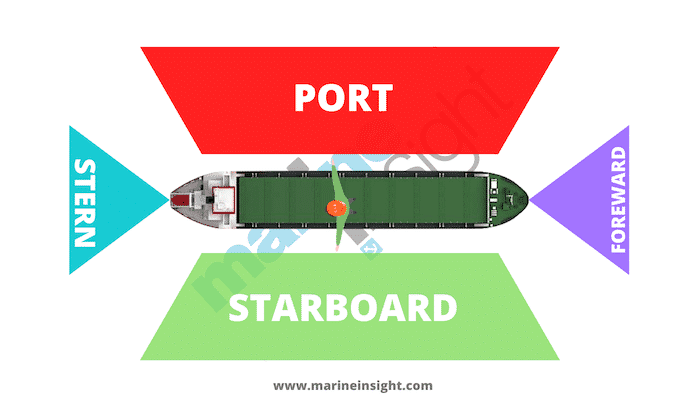Communication plays a major role in the maritime industry, whether it be between crew members, officers or between two ships.
Ambiguity and confusion are the primary causes of accidents and untoward incidents that happen onboard ships and other vessels.
When crew members speak a wide variety of languages, there can be some confusion in the meaning of phrases that they wish to convey.
To compound this problem, ships and seafarers travel all over the world. They can fly a flag of one country, have a captain of another, and a crew of at least 7 to 8 different nationalities.
Without a common language, there can be difficulty in passing instructions among officers and crew members.
This is where Maritime English comes into play.
Building on the basics of everyday English, certain maritime terms have been adopted by the maritime and shipping community.

By having a set of terms unique to this domain, it rules out any possibility of confusion in meaning. A major issue with using normal terms such as left or right, front or back, etc. is the ambiguity associated with the directions.
For instance, say the captain issues an order changing direction by 5 degrees to the left. Whose left is to be taken for consideration in this scenario?
If the captain and the crew member controlling the navigation are in different locations, there can be quite a bit of confusion in this regard.
Furthermore, if the crew member is facing in a different direction, the ship may proceed off course, leading to possible damages. Thus, terms that can be used irrespective of one’s orientation and location are extremely important.
Similarly, front and back face an issue with the relative direction. These issues are solved by adopting a common set of terms and phrases, used by all seafarers across the world.
This is known as Maritime English and is also referred to as the Standard Maritime Communication Phrases (SMCP).
SMCP has been developed by the International Maritime Organization (IMO) as the international standard for all maritime communication.
As English is considered to be the common language while at sea, Maritime English builds on the basic vocabulary of English while including unique phrases and terms to rule out any possible ambiguity.
It primarily serves three main functions-
1. Ship to ship communication
2. Ship to shore communication
3. Internal communications onboard a ship
Origin and Uses of Maritime English
SMCP or Building on the basics of everyday English, certain maritime terms have been adopted by the maritime and shipping community. Maritime English is thus various combinations of the English language and certain fixed phrases.
Seaspeak is known as a Controlled Natural Language (CNL) and borrows heavily from a limited English vocabulary.
In phrases where finding an appropriate English word may be difficult, terms from other common languages are also used. Seaspeak was developed at a conference of the International Maritime Lecturers Association (IMLA) in 1985.
It underwent multiply updates that aimed at improving the language to account for all possibilities of communication that may arise while at sea.
Eventually, it was combined with the Standard Maritime Navigational Vocabulary (SMNV) to form the SMCP language. This was in response to accidents that took place due to confusion in commands.
Ultimately, the SMCP was adopted in the 2001 conference of the IMO and has been in use since then. It aims to reduce language and communication-related accidents.
In a study conducted on the most common causes of maritime accidents, over 50% of the incidents were due to some form of miscommunication, and of these incidents, just under half was due to the improper use of SMCP and IMO approved phrases. Thus, it is important to equip all seafarers with sufficient knowledge on how to effectively communicate while at sea.

Commonly Used Terms Of Maritime English
There are some terms unique to the maritime sector that is a part of SMCP.
Firstly, direction plays a major role in navigation while at sea. Using lay terms such as right, left, front or back can be ambiguous. For this purpose, there are terms specific to ships.
The front of the ship is referred to as the bow or fore. The region at the back where the propellers are housed is known as the aft or stern. The region in between the aft and bow is known as the midship.
Similarly, when viewing the vessel from the stern to the fore, the left-hand side is known as the Port side, while the right side is the Starboard side.
The various horizontal levels on the vessel are known as decks, while the base is known as the keel. Another important term that is used is the draft of a vessel.

The draft refers to the depth of a vessel that is below the waterline. Thus, when the captain says that the fore-starboard region on deck 4 is out of bounds, he implies that the area to the front right-hand side of the vessel cannot be accessed by unauthorized personnel. Deck 4 is the number allotted to that particular deck which is inaccessible.
Another part of the ship that has a specific maritime name is the elevated area in which the captain and officers work. This is called the bridge of the ship and serves as the main heart of the vessel. Another term used in direction is abaft, which indicates an object being relatively closer to the stern. Thus, the rudder is abaft to the propellers on most conventional ships.
Abandon ship is a term used on ships to imply that a disaster has occurred and that the ship will eventually sink. It is an order issued by the captain to indicate that passengers and crew members are to board rescue vessels or life rafts and follow emergency protocols. Another accident that may occur is when a ship runs aground. In such situations also the call to abandon ship may be issued. When a ship is said to capsize, it turns over such that the keel is above water while the decks may be fully submerged. In such situations, the vessel is said to be taking on water.
An interesting way of referring to windows and doors within a ship is by calling them access holes. Similarly, the passages within a vessel are called alleyways. The gangway refers to a structure similar to a ladder that permits boarding of a vessel. The windows cut out into the hull of a ship is called portholes. The pennant refers to a flag that a ship is flying. This can either be a flag of convenience or a flag under which a warship operates.
The course of a ship refers to the path it is taking. This path can also be determined by referring to the absolute bearing of a vessel. This type of bearing gives the direction of the vessel with respect to true North. When the order to stow something away is given, it indicates that a particular object must be stored in specifically assigned locker or bunker.
The ballast of a ship refers to additional water that it takes on board-specific ballast tanks to lower itself in the water. A berth refers to a place assigned to a ship at a port. It can either be for loading, unloading or just as a port of transit.
Lastly, there a few terms referred to as message markers. They are used to prefix certain statements to clarify their meaning in case of poor communication. These include keywords such as “INTENTION” that means the seafarer is about to state a probable course of action.
“WARNING” suggests a possible warning issued by the authorities to a vessel. “ADVICE” is used to provide suggestions to the officers of a vessel regarding heading and a course. A “REQUEST” implies that some aid or facility is required by a ship. Another similar type of message marker is the QUESTION-ANSWER phrase, that is discussed in the next section.
Common Phrases and Examples Of Maritime English
One of the most common phrases used while at sea is “Say Again”, which indicates that the receiver was unable to understand the message and needs it to be repeated. This comes in place of other more complicated phrases that can be lost while in the relay. Instead of lengthy sentences such as “I could not hear you” or “Please repeat yourself”, this two-word phrase is short and to the point. It also has a lesser likelihood of being misunderstood or misheard.
Another very common set of phrases that are used in the maritime sector is the “QUESTION – ANSWER” group. Instead of asking a question using phrases such as “Should I” or “May I”, the seafarer can use the term QUESTION as a prefix to his query.
This states his intention and allows the receiver to understand that he has a question. In response, the receiver particularly uses the term ANSWER prior to answering the query. This ensures that the seafarer at the other end knows that his query is being addressed. Thus, using these 2 prefix phrases, ambiguity about the nature of the conversation can be removed.
In case of some accident or issue, sentences such as “I am in trouble” or “I need help” can be easily misunderstood, especially in bad weather with poor broadcasting. Instead, the phrase “I require assistance” ensures that the message is not lost or misunderstood.
Prior to starting this phrase, it is advisable to also mention the reason or cause for your accident. This could be due to icing or immediate danger of sinking. After issuing the standard mayday and distress calls, it is also prudent to mention if any particular type of assistance is required and to also enquire into the ETA of the rescue vessel.
This is useful when it comes to reducing wasted time. By stating the issuing that you are facing and the type of aid required, the rescue team can send a group that is prepared to help you in this regard. They can also inform the shipowners of any complications and seek their help in understanding the layout and design of the vessel. SMCP plays a major role in disaster scenarios, as any miscommunication in such cases can have major consequences.
Certain distress signals can be used depending on the severity of the issue. The phrases Mayday-Mayday-Mayday, Pan-Pan-Pan and Securite-Securite-Securite are all used to indicate some form of distress information. Each varies in severity, with mayday implying a major issue with a high probability of sinking.
Securite is the least severe and is a French word used to simply indicate that the information following the signal contains important safety directives. Lastly, SOS is a common distress signal, which originated from the phrase “Save our Souls” or “Save Our Ship”. Most distress signals are repeated three times successively, to ensure that the message is carried out and is not lost in any possible miscommunication.
How to Use Maritime English
Using this type of language can be challenging for beginners. That is why it is important to pick up the nuances of conveying information. While conveying any message, it is important to ensure that the complete data is transferred.
Similarly, when speaking to passengers or crew members, it is also good practice to give them a brief idea of what to expect in a particular scenario. In this section, we will look at some common sentences and phrases used by seafarers in maritime English.
“Ship has run aground. I require assistance. Kindly provide rescue vessels to location … Passenger and crew count totalling one-five-zero.”
The phrase is short and to the point. It indicates that the ship is in some form of distress and requests for assistance. The type of rescue and the location has also been provided. In addition, it allows the rescue team to know that they will have to look for a total of 150 individuals during search operations.
“Possible piracy attack. Location … and heading … I require immediate assistance. What is ETA of backup?”
By implying immediate danger and enquiring into the ETA, the person has conveyed a significant amount of information in just 3 short phrases.
Using the heading and course, a possible piracy attack can be thwarted by sending troops or a warship to the affected region.
One can also use single-word message markers to convey a message.
“QUESTION. What is the ETA of your vessel?”
“ANSWER. ETA zero nine hundred hours GMT.”
This exchange conveys the required information in an understandable manner. The person answering the question is conveying their estimated time of arrival (ETA) to be at 9 am GMT.
It is common to use military time standards using 4 digits in a 24-hour format. This removes ambiguity about the time into consideration.
Similarly,
“WARNING. Proceed with caution. Iceberg ahead.”
“INSTRUCTION. Stay on traffic lane 1.”
“REQUEST. Dispatch pilot immediately.”
“INTENTION. Vessel to move to traffic lane 1.”
When speaking to passengers over a PA system, using maritime English is also advised. In case of an emergency, take this opportunity to reassure the passengers and reiterate that the crew are doing everything in their power to improve the situation.
For instance,
“This is Captain … Passengers are advised we have collided with another vessel. Minor fire on the upper deck. No imminent danger. Firefighting measures being implemented. In case of adverse conditions, you are advised to prepare for possible evacuation by heading to assembly areas nearest to you. Further information will be relayed by either me or members of my crew.”
Although this is evidently a stressful situation, the captain has conveyed a calm and composed message that boosts confidence among passengers.
Even during normal procedures, officers often communicate with passengers in maritime English. For example, once boarding has been completed, the captain often welcomes passengers and briefs them about basic safety guidelines.
“Ladies and gentlemen. This is Captain … This is to inform you that we have left the port. We are currently at heading … with favourable weather conditions. The stern and bow doors have been secured and you are advised not to venture to zones … ETA at our destination is 1600 hours GMT.”
By sticking to maritime English phrases, one is able to ensure communication without any probable issues. In addition, it reflects a calm and collected demeanour that suits officers and crew members of sailing vessels.
How to Obtain Maritime English Certification
Budding seafarers are often not provided with the opportunity to learn proper maritime English. This acts as a disadvantage when applying for jobs and when trying to move up the industry ladder.
That is why several private and government bodies offer third-part certification in maritime English. Along with teaching you the basics and more advanced phrases, they also provide documentation that shows your proficiency in the course.
The primary step to learning maritime English lies in picking up basic English terms. This can be especially challenging for non-English speakers, but there are a variety of courses out there that can help you in this regard.
The next step is to attempt one of the many certification exams conducted by authorized bodies around the world. With the documentation provided by them, one can apply for jobs in the maritime sector.
One of the most common tests taken by seafarers looking to pick up SMCP is MarTEl, which stands for the Maritime Tests of English Language. Provided by the European Union (EU) under a funded learning program since 2007, it combines standards from both IMO and SMCP. The project uses 3 grades provided by joint partners from around Europe to provide maritime English certification to seafarers.
Seaspeak, or Maritime English as it is more commonly known today, refers to key phrases used in the maritime industry to prevent accidents because of a difference in language fluency. It removes ambiguity in common everyday phrases and instead replaces several words with more relevant terms. From the crew to the officers, everyone must be up to date on the latest terms and usage of maritime English. A large number of courses can be found- both online and in-person, which provides certification for budding maritime seafarers.
By using the correct terms, information can be conveyed between members of a ship. It even ensures that 2 captains who speak different native languages can still understand each other. In addition to replacing common English phrases and words, maritime English also uses certain codes to indicate various occurrences. This can include fires, leaks, a probable chance for sinking etc. When used correctly, it can be immensely useful in the maritime world.
And now over to you. Do you know any other interesting maritime English terms? Share your thoughts in the comments section below…
Disclaimer: The authors’ views expressed in this article do not necessarily reflect the views of Marine Insight. Data and charts, if used, in the article have been sourced from available information and have not been authenticated by any statutory authority. The author and Marine Insight do not claim it to be accurate nor accept any responsibility for the same. The views constitute only the opinions and do not constitute any guidelines or recommendation on any course of action to be followed by the reader.
The article or images cannot be reproduced, copied, shared or used in any form without the permission of the author and Marine Insight.
Source:marineinsight








